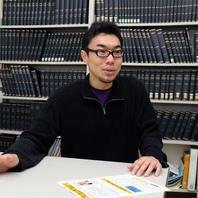![]()
![]()
Research Support Office Research Advancement Division. Tokyo University of Agriculture and Technology
| TEL | +81-42-367-5944 |
|---|---|
| FAX | +81-42-367-5946 |
This program is supported by MEXT’s scientific technology human resource development fee grant, "Program to Disseminate Tenure Tracking System".
Home > Tenured Faculties > Koyama Satoshi

Koyama Satoshi

| Research experience | ・2009.4-2011.3:Kurume University School of Medicine Assistant Professor |
|---|---|
| Educational background | ・Tokyo Univeristy of Agriculture and Technology 2004 B.S.(Veterinary Medicine) |
| Awards | |
| Selected papers and publications | (At Jan. 2017) |
Various behavioral traits have been evolved in animals to survive and breed to leave as many offspring as possible. Some traits may be disadvantageous superficially, but can evolve when the genes governing the traits transmit effectively to the next generation, often through relatives. One example of such traits is sterile workers in social insect.
Social insect is the insect with the castes based on division of labour. Social insect include Hymenopteran ants and bees. Hymenoptera has a unique system of sex determination, which is called haplodiploidy. The number of chromosome in male is n, whereas that in female is 2n. This results in that relatedness among super-sister, sharing both parents, is 3/4, among half-sister, sharing mother but not father, is 1/4. Thus, there is large difference in the relatedness among individuals within a colony of polyandrous species. Furthermore, the relatedness between male and worker show more complicated situation. The relatedness is different when it is calculated from the worker and when it is from the male. Because of these interesting phenomena seen in the society, social behaviours of Hymenopteran have been eagerly studied. However, the relationship between Hymenopteran and parasite is not well understood. In other species, some parasites manipulate host behaviours. I am going to investigate whether parasite manipulate host in this species, or status of parasite depends on host caste to elucidate the relationship between Hymenopteran host and parasite.
The tenure track program is a very good system in that the young researchers establish their own research. In this system, the academic achievement will be evaluated and we need to overcome the hurdles to acquire the tenure position. Unlike profit-making company, education and research at university is required to contribute to continuous academic development and training of students. It is important to consider how this system applies to these peculiar tasks of university.
The scientific research progresses very fast these days, and I have to come up with it to polish myself up. Students at TUAT have good ability and what I should do for their training is to make good environment for the students to bring their ability into full play. To achieve it, academic staff and students are needed to function as a team. Collaboration with foreign researchers may facilitate it, hopefully with remarkable research progress.